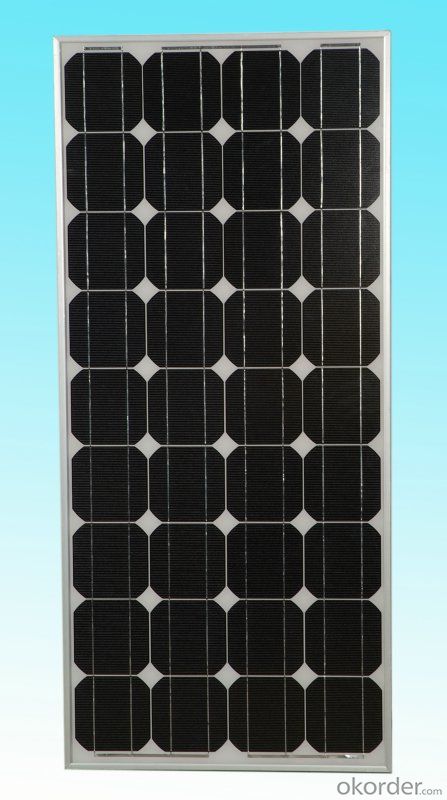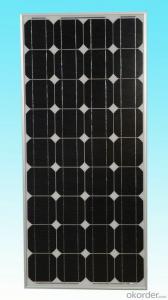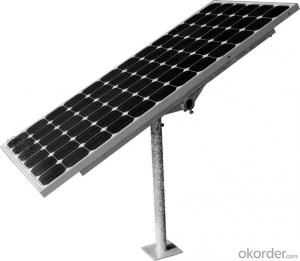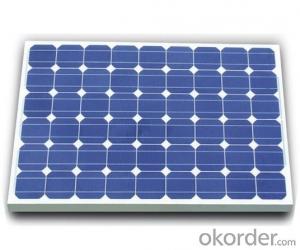Mono Solar Panel 90W /Solar Panel 90W for Sale
- Loading Port:
- Shanghai
- Payment Terms:
- TT OR LC
- Min Order Qty:
- 10000 watt
- Supply Capability:
- 1000000 watt/month
OKorder Service Pledge
OKorder Financial Service
You Might Also Like
Item specifice
Product Description

Mono solar panel 90W /solar panel 90w
Solar Cell : High efficiency crystalline solar cell. Even if under the weak light, the solar module can produce maximum power output.
Tempered glass (toughened glass): Anti-reflecting coating and high transmission rate glass increase the power output and mechanical strength of solar module.
EVA and TPT: Using high quality EVA and TPT to prevent destroying and water.
Specifications for Mono-crystalline Silicon Solar Module with 90W Maximum Power
| Mechanical Characteristics | |
| Cell type | mono-crystalline silicon solar cells |
| Cell layout | 4*9 |
| Number of cells | 36pcs |
| Module dimensions | 1198*537*35mm |
| Frame | anodized aluminum,grey or black |
| Junction box | IP65 |
| Connectors | MC4 or MC4 compatible(optional) |
| Net weight | 7.6kg |
| Packing | 2pcs/ctn |
| Electrical Characteristics | |
| Peak power(Pmax) | 90W |
| Power tolerance | ±3% |
| Max.system voltage | 715VDC |
| Open circuit voltage(Voc) | 21.5V |
| Short circuit current(Isc) | 5.73A |
| Max.power voltage(Vmp) | 17.5V |
| Max.power current(Imp) | 5.14A |
| Temperature coefficients of Isc | 0.035%/ºC |
| Temperature coefficients of Voc | -0.33%/ºC |
| Temperature coefficients of Pmax | -0.43%/ºC |
| Cell Efficiency | ≥17% |
| FF | 73% |
| Standard Test Condition(STD) | Irradiance:1000W/m²;Cell temperature:25ºC;AM:1.5 |
Features:
1) High reliability with guaranteed +/-3% output power tolerance
2) The modules can withstand high wind-pressure, snow loads and extreme temperatures
3) Bypass diodes to minimize power loss with shading
4) High and stable conversion efficiency to ensure the highest quality
Quality and Safety
1) Industry leading power output warranty, 25 year 80%, 10 year 90% power warranty and 3 year power warranty
2) ISO9001: 2008 (Quality Management system) certified factory
3) Product Quality warranty & products Liability Insurance to guarantee and user' benefits
EN 6100-6-3: 2007 EN 6100-3-1: 2007(IEC 61000-4-2: 2008
Our advantages:
High quality materials: High insulation TPT, Anti-aging EVA
Focus on each process during manufacture
Experienced engineers and workers
Fast delivery: 7-15 DAYS High efficiency and long time warranty
- Q:Are solar panels noisy?
- No, solar panels are not noisy. They do not have any moving parts and therefore, do not produce any noise while generating electricity from the sun.
- Q:I have a cabin that is way out in the middle of no where, it would cost 000's of dollars to get power to it. If I have a 8,000 BTU air conditioner that runs on 25 volts and 5 amps (or 875 watts)How many solar panels will I need to run this during the day, plus charge the batteries to run it all night? How many batteries would I need
- OK, in addition to the solar panels, you wil need an inverter (DC to AC; 2V t0 20V) capable of delivering 20A continuously and as much as 40A for the compressor starting surge, and a fairly large battery bank capable of delivering something over 2000 watts continuously (losses in the charging and conversion process) as well as the surge. So, if your actual demand is now calculated around 2000 watt/hour, and you need to both run the unit and charge batteries during the daylight hours - and considering that the ideal charging rate for a lead-acid battery is on the order of 0% of its capacity, you will need a huge reserve on the battery section and a huge excess on the solar section to make up for the 5 hours maximum input. So, the average high-quality deep-discharge battery will do about 400Ah @ 2.6V. Which comes to 5040 watts for one hour. For round figures, it will give you 2000 watts for 2.5 hours. You will need a minimum of eight of them just to make your system run for the 9 hours you are anticipating. Given that you do not want to run the batteries to zero each night, a 50% reserve would be a wise investment - comes to now twelve (2) batteries. Now, you will have to make 2000 watts (to run the unit) and also produce and another 8600 (per hour for five hours) watts to charge the batteries for the next night. Again, for round figures, you will need 0,000 watts of solar power, or seventy (70) panels. At ~0 watts/s.f. (00 watts/meter), that comes to about 000 square feet or 00 square meters. Modern non-crystaline panels may reduce this by 20%, or so but no more than that. You will be charging the batteries at roughly 20% of their discharge capacity - which will pretty much cut their service live in half, or so. As the average deep-discharge battery has about an 8-year life span under ideal conditions (and your situation will be far from ideal) you may expect to replace them every four years or so with good care. Much less with no care.
- Q:How do solar panels generate electricity?
- Solar panels generate electricity through the photovoltaic effect, where sunlight is converted into electricity. When sunlight hits the solar panels, the photons in the sunlight knock electrons loose from their atoms, generating an electric current. This current is then captured and converted into usable electricity for powering homes and businesses.
- Q:i see these things all over the internet on how to make 'home made solar panels' but all of them require you to buy the solar cells and nothing tells you how to make your own. So how can you make your own solar cells?
- DIY okorder
- Q:what do I need to do to disconnect a solar panel from a battery to protect the panel?
- Know that solar panels almost always incorporate a blocking diode to prevent a battery from back-feeding through an un-illuminated panel. Know that solar panels are usually connected to a battery via an electronic switching charge controller, not directly connected. Know that when a solar panel is open-circuited (disconnected from everything) it's terminal voltage will rise to almost twice it's nominal voltage. (22V is common for a 2V panel), unless it is stored in total darkness.
- Q:If you were to be asked to write a material(s) report on either -solar panelsor -aircraft fuselageWhich would you choose?well i was asked to choose between these two,so i guess that if i choose what the majority wouldn't, i might just score a little bit higher,what do you think?if you are the lecturer you would want something different right?
- Solar Panels. Solar panels is a generic term for any semiconductor that converts solar energy to electrical energy. However there many different kinds of solar panels and constructed in different ways from different materials. There is the generic polysilicon solar panels for residential installation on one end of the spectrum. On the other end are very high efficiency (and expensive) solar cells used on the Mars Orbiter that are constructed of so called triple junction GaAs/Ge solar cells. In addition there are also the thin film solar cells that are being researched that use Cadmium Telluride (CdTe) to form junctions and make very efficient cells on very thin substrates. I would say that research into materials that can be used for solar cells is one of the hottest research fields right now. (That being said, I really did enjoy Airframe by Micheal Crithon. Whenever I'm in a plane during bad weather I always thing of the engineers that designed the plane... what assumptions did they make... what tradeoffs did they make... )
- Q:I live in Los Angeles area, I see the ads that, they will install solar panel for $0. I would like to know what is the catch ?Thanks You.
- The catch is you pay a monthly electric bill to the company that installed it. There are a couple ways to pay for solar power. One way is to pay the full cost of installing it then get all the power it makes at no cost. The other way is they install it for free and they become like a second power company. You pay them for the solar power and still pay your electric utility for any power from their generator that you use. The idea (usually a promise) is that the monthly rate will be lower than the power company charges. I would prefer to pay the full cost of the installation and own the power it makes from then on. But you need to have enough cash, or the ability to borrow enough, to pay that way.
- Q:First of all is it possible? I do not know how much electricity my dehumidifier but could someone give me an idea of how much this would cost to do? A link to a solar panel or equipment that would do the job would be nice too.Thanks in advance.
- This Site Might Help You. RE: What do I need to do to run my dehumidifier from solar panels? First of all is it possible? I do not know how much electricity my dehumidifier but could someone give me an idea of how much this would cost to do? A link to a solar panel or equipment that would do the job would be nice too. Thanks in advance.
- Q:Can solar panels be used to power a school?
- Yes, solar panels can definitely be used to power a school. Solar panels convert sunlight into electricity, which can be used to power various electrical systems within a school, including lighting, heating/cooling systems, computers, and other appliances. By harnessing solar energy, schools can reduce their dependence on traditional sources of electricity and contribute to a more sustainable and eco-friendly environment.
- Q:Can solar panels be installed on hospitals or healthcare facilities?
- Yes, solar panels can be installed on hospitals or healthcare facilities. In fact, many healthcare facilities are increasingly adopting solar energy as a sustainable and cost-effective solution. Solar panels can help hospitals reduce their dependence on traditional energy sources, lower operating costs, and contribute to a greener environment.
1. Manufacturer Overview |
|
|---|---|
| Location | |
| Year Established | |
| Annual Output Value | |
| Main Markets | |
| Company Certifications | |
2. Manufacturer Certificates |
|
|---|---|
| a) Certification Name | |
| Range | |
| Reference | |
| Validity Period | |
3. Manufacturer Capability |
|
|---|---|
| a)Trade Capacity | |
| Nearest Port | |
| Export Percentage | |
| No.of Employees in Trade Department | |
| Language Spoken: | |
| b)Factory Information | |
| Factory Size: | |
| No. of Production Lines | |
| Contract Manufacturing | |
| Product Price Range | |
Send your message to us
Mono Solar Panel 90W /Solar Panel 90W for Sale
- Loading Port:
- Shanghai
- Payment Terms:
- TT OR LC
- Min Order Qty:
- 10000 watt
- Supply Capability:
- 1000000 watt/month
OKorder Service Pledge
OKorder Financial Service
Similar products
New products
Hot products
Hot Searches
Related keywords





























